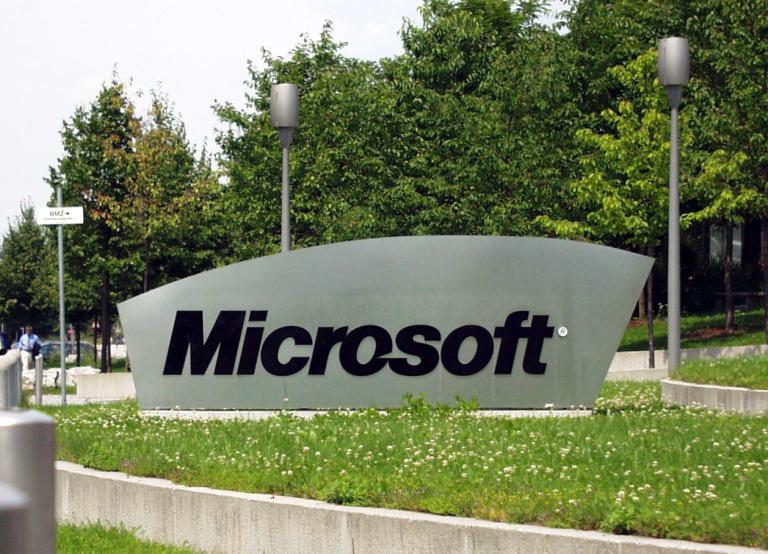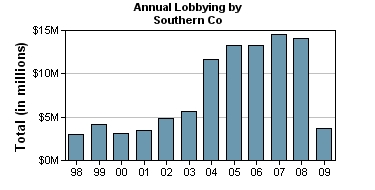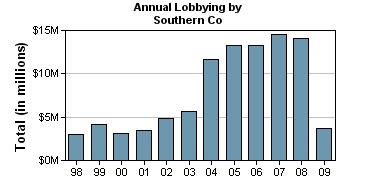Who is behind the push for “clean coal”?
Seems like it ought to be simple, but it’s not. Take a look at this list of members of the “clean coal” front group ACCCE. There are effectively three lobbies: producers, utilities, and legislators.
Producers’ interest in “clean coal” is obvious: they want to sell more coal. Big hitter Peabody (who was all up in the G.W. Bush administration) dropped some $8.4 million on lobbying in 2008, to say nothing of generous direct contributions to Reps. John Shimkus (R-Ill.), Joe Barton (R-Tex.), and Rick Boucher (D-Va.).
Then there are the southern and midwestern utilities. Their interest in “clean coal” is more interesting, though no less generous. The biggest utility in the country, American Electric Power out of Ohio, was the largest single contributor to both Republicans and Democrats in 2008. Southern Co. out of Atlanta, the second largest U.S. utility, dropped $14 million lobbying in 2008.
Check out what it pulled in 2003:
Southern Co. hired a new congressional lobbyist this week, and a Washington-based environmental group is crying foul.
The lobbyist is John Pemberton, chief of staff of the division of the federal Environmental Protection Agency that delivered a key Clean Air Act victory last week to the nation’s coal-fired utility industry, led by Southern Co. [my emph.]
Ballsy. But Southern’s been managing politicians for years. In fact, when it comes to regulated utilities like Southern, you could say that regulator management is its business model. A regulated monopoly can’t go out of business and its profits are guaranteed; these are not conditions that foster innovation. For decades, utility executives have profited by maintaining a steady course. A recent Atlantic story called “Do CEOs Matter?” contains this gem:
[The CEO] doesn’t make much difference at electrical-utility companies, which are so constrained by government regulations and the cost of fuel that there’s very little room for the CEO to exercise any discretion. The professors used the term “Titular Figureheads” for such CEOs.
With reach across the Southeast, Southern has large stable of old, dirty coal plants grandfathered under the Clean Air Act, cranking out more pollution than those of virtually any other U.S. utility. It’s been in the business for going on 90 years, doing what it does best: building and running large, remote coal power plants and selling as much of the juice as possible. Indeed, that’s what the regulatory framework mandates, what it has always mandated.
Enviros have occasionally forced it to do some cleanup. It’s had to stick pollution reduction gizmos on its smokestacks and water discharge systems. But nothing has threatened its basic identity like climate change (the existence of which it denied for many years). The easiest defense, the one that best protects the status quo, is installing a new pollution reduction gizmo and calling it good. “Clean coal” is the latest gizmo, or at least the industry desperately wants it to be.
Southern is not one of these newfangled “decoupled” utilities: it makes money by deploying capital, building plants, and selling power. That is what it knows. And when all you have is a pollution scrubber, everything looks like a smokestack. The only way it can imagine itself in a low-carbon world is by taking the carbon out of what it does now:
… compared to the energy sector as a whole, the company’s commitment to alternative techniques has been modest. Leonard Haynes, Southern’s executive vice president in charge of such alternatives, says that when it comes to renewable energy, the company is putting its main effort into biomass while “focusing on finding niche opportunities for wind and solar.”
“The best thing to understand,” Haynes says, “is that the opportunities for renewables in the Southeast … are not as great as in other areas of the country.”
That’s highly disputable, as we’ll see later, but for now it’s just worth noting that this is what southern legislators hear constantly from their very good friends in the utility world: there are no renewables in southern states and efficiency is a marginal contributor at best. The solution is give utilities like Southern lots of taxpayer money to build and deploy huge new (clean!) coal plants and fat new transmission lines.
The same message reaches lawmakers in heavy industrial states: until “clean coal” comes along, “low-carbon power” just means “more expensive power,” which means “industries moving elsewhere.”
So producers, utilities, and heavy industry agree: let’s do more or less the same thing we’ve been doing, only with taxpayers giving utilities tons of money to build high-tech new plants. “Clean coal” is where it’s at! If that’s what a legislator hears day in and day out, how will he or she approach climate/energy legislation?
More on that in the next episode of … [music swells] … Southern Utility Blues [dramatic timpani]!




